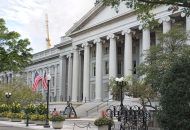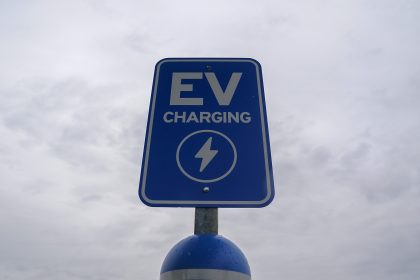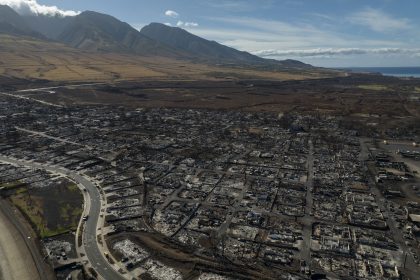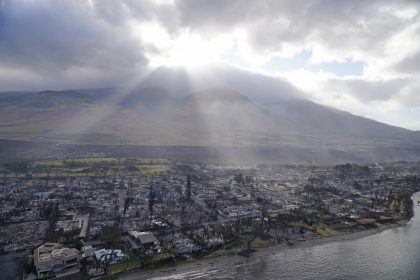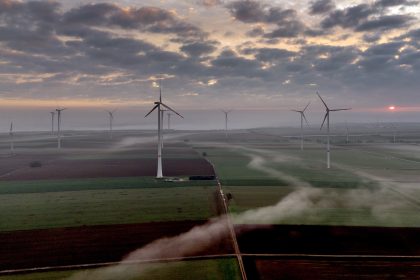Diverse Coalition Urges Next Congress to Be Proactive on Climate Risk Mitigation
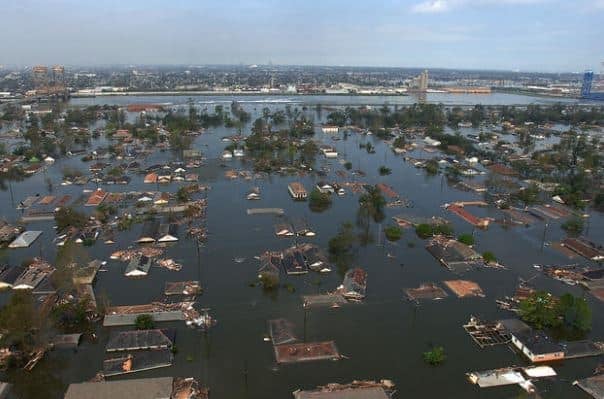
WASHINGTON — The change in House leadership next year is likely to renew the long-running congressional debate over how to fix problems that have plagued the National Flood Insurance Program for decades and make it better able to deal with the realities of accelerating climate change.
One group that is already making its voice heard on the issue is the SmarterSafer coalition, which earlier this month released a report calling for a greater emphasis on resiliency and pre-disaster mitigation, policy changes it says could save American taxpayers hundreds of millions, if not billions, of dollars annually.
“In short, we want to solve major problems, while also being responsible stewards of taxpayer dollars,” Chris Brown, the group’s executive director, told The Well News last week.
“While it’s crucial that we continue to have the bigger conversations on environmental protection, climate change and federal spending, we’ve got to simultaneously move the ball forward on some common sense, nonpartisan — and yes, perhaps incremental — initiatives.”
The conversation is particularly timely, not only because of the change in leadership in the House, but also because as part of their passage of the massive $1.7 trillion omnibus spending package, lawmakers in the chamber on Friday also reauthorized the current National Flood Insurance Program, extending it through Dec. 23, 2023.
The roots of the brewing debate over what to do next go all the way back to August and September 1965, when Hurricane Betsy struck New Orleans, Louisiana, and, before all was said and done, killed 71 people while causing more than $1.2 billion in damage.
In response, three years later, Congress passed the National Flood Insurance Act of 1968, under which the federal Treasury effectively became the nation’s insurer-of-last resort.
Under the scheme worked out by lawmakers at the time, private insurance companies began to administer flood insurance policies for a fee and the federal government would assume the risk and subsidize some premiums.
The act also directed local communities to adopt floodplain management ordinances, and assigned the federal government the role of administering newly created flood insurance rate maps.
The idea was to provide coverage to at-risk homeowners who couldn’t otherwise get it through the private market while discouraging future building in flood-prone areas.
The problem is those lofty goals never completely came to fruition. In the 57 years since the original act was passed, many at-risk homeowners did indeed get insurance coverage they couldn’t get on the private market.
But at the same time, real estate developers, local lenders and local governments continued to fulfill the dreams of the millions of people who want to live in waterfront or water-adjacent properties.
The result was coastal development went on nearly unabated in areas that were both ecologically sensitive and at a high risk of flooding (think South Florida, as an example), while the National Flood Insurance Program prices insurance far before the actual cost of the risk.
It doesn’t take a genius to see that as a recipe for disaster.
According to the National Oceanic and Atmospheric Association’s Office for Coastal Management, over 128 million people, or almost 40% of the nation’s total population, currently live near a coastline or significant body of water.
And repeated disasters — like Hurricane Ian, which tore through Fort Myers, Florida, last fall — have plunged the insurance program into tens of billions of dollars of debt.
On its current trajectory, there’s little hope for NFIP to pay back its $20 billion debt without congressional intervention.
SmarterSafer entered the picture in mid-2007, after the House passed legislation that would have made taxpayers responsible for a large portion of the nation’s coastal insurance costs.
The net result of the bill, conservative, free market activists believed, was that the federal government was going to upend the property insurance market by selling subsidized insurance premiums for far less than private insurance companies could.
This, the activists argued as the bill advanced, would only continue to enable more destructive and costly development along the cost. They wrote letters, testified in hearings, but, as often happens, bigger issues — namely the debate over the creation of the Affordable Care Act — sucked up both the air in the room and the media bandwidth.
But it was at this point that the ad hoc group of advocates, most with ties to the business, insurance and anti-tax advocacy worlds, discovered they had some unexpected allies — members of the environmental community.
While there was much they did — and continue — to disagree on, the free marketeers and the environmentalists were of like mind about one thing in particular — the current structure of the National Flood Insurance Program wasn’t good for any of them.
Soon, an actual coalition representing both constituencies was formed under the banner of Americans for Smart Natural Catastrophe Policy. It became SmarterSafer.org a year later.
Chris Brown became acquainted with the organization while working on Capitol Hill, first with Rep. Blaine Luetkemeyer, R-Mo., for whom he served as deputy chief of staff and Financial Services Committee designee during Luetkemeyer’s chairmanship of the subcommittee on Financial Institutions and Consumer Credit, and then with Rep. Patrick McHenry, R-N.C., running member of the House Financial Services Committee.
Prior to that Brown worked in a number of roles in the George W. Bush administration, including at the White House, the Environmental Protection Agency and the Department of the Interior.
Looking for a change after 15 years on the Hill, Brown initially joined the staff of Mindset, a Washington, D.C.-based bipartisan strategic advisory and advocacy firm. However, SmarterSafer continued to intrigue him.
When the opportunity arose, he jumped at the chance to be its executive director.
“It really is a very different, very unique group,” he said. “Because it’s not just insurance companies that are involved, or reinsurance interests, but it combines those private sector experts with environmental advocates, taxpayer focused groups and housing advocates … a very compelling group that has a very compelling narrative to tell.
“It’s rare in Washington to find strange bedfellows like these really coming together to bridge partisan divides in the interest of policy development,” Brown continued.
“The other thing that intrigued me was the scope of what they were trying to do; on the one hand they were talking about very tangible issues — flood insurance rates and what it means when they go up, and raising important questions around affordability.
“And interestingly enough,” he said, “what they encountered wasn’t a partisan divide on these things, but a geographical divide, because almost every member has constituents they want to help in regard to these issues.
“At the same time, there were more, say, ethereal issues they were wanting to address. ‘How do you combat climate change?’ ‘How do you stem the risks of natural disasters?’”
Members of the coalition include the American Property Casualty Insurance Association; Association of Bermuda Insurers and Reinsurers; Liberty Mutual Group; National Association of Mutual Insurance Companies; National Flood Association; R Street; National Taxpayers Union; Taxpayers for Common Sense; Center for Climate and Energy Solutions; Defenders of Wildlife; Natural Resources Defense Council; National Wildlife Federation; Surfrider Foundation; Coalition to Reduce Spending; Natural Hazard Mitigation Association; Habitat for Humanity; National Housing Conference; American Consumer Institute; and Friends of the Earth, among others.
Brown said because the organization is so diverse, the challenge is mining the members’ very “stringent” individual interests and determining which instances and policies it makes the most sense for them to work together on.
“That fact is, there are smaller, incremental steps that this coalition can take on behalf of its members, that deliver immediate value to the environment, immediate value to taxpayers and immediate value to the communities that are impacted by natural disasters.
“And a lot of the consensus revolves around a shared notion that as a nation, we have to get out of our own way,” he said.
To Brown that means placing a renewed focus squarely on pre-disaster mitigation and resiliency efforts, “things that unfortunately have been somewhat overlooked in previous Congresses.”
“And now, I think for the first time, we’ve got both Democrats and Republicans saying, regardless of where we are on the bigger issues, we can’t keep plowing money into disaster supplementals; we have to start thinking more proactively and preventatively on these things,” he said.
Brown admitted that climate change is still seen as more a political statement than a reality by some factions of the party about to take control of the House in a matter of days.
But he said more and more Republicans are talking about the need “to really address climate change head on.”
“I mean, regardless of where you fall on the climate as a larger issue, when you look at the financials behind it … the economics and the spending … you can’t get away from the reality that we just constantly are plowing money into post-disaster response, which does not benefit the environment, and doesn’t do a ton to benefit the communities who have been hard hit by a disaster and are likely to face disasters again.”
The coalition’s paper isn’t exhaustive, but it lays out the argument that investing more in pre-disaster mitigation and resiliency efforts are strongly aligned with what Brown referred to as “conservative principles.”
“In other words, it’s much more [sensible] to mitigate and prevent potential losses before a disaster strikes, when the costs after the fact — the cost of doing nothing ahead of time — can be astronomical,” he said.
“There are studies that have shown that every dollar invested in pre-disaster mitigation saves between $11 and $13 in post-disaster recovery. And it’s spelled out in our report,” Brown said. “And yet we continue to advance and reauthorize disaster supplement spending to deal with the same problems year after year.
“We continue to advance and reauthorize the National Flood Insurance Program, knowing full well that it’s the only government subsidized program that actively incentivizes Americans to live in harm’s way.
“So the question of funding really isn’t necessarily about having to find new pots of money to throw at problems, it’s about reprioritizing what’s already being spent,” he said.
According to Brown, the X factor driving these conversations is the climate itself.
“As I said earlier, there’s a strong interest among those representing people in waterfront and flood-prone areas to protect those constituents,” he said. “And that number is growing based on the trends in disasters.
“More and more congressional districts are being impacted by natural disasters. We’re seeing much broader inland flooding due to hurricanes and sea level rise. Tornadoes are far more frequent, and wildfires are far more devastating than we’ve seen previously. Droughts are impacting our agricultural districts,” he said. “As a result, we’re seeing more policymakers putting forth legislation that strikes the right balance, that can garner bipartisan support while still going far enough to make a meaningful difference.
“And I think what needs to be said is, if we’re going to be giving money to programs through the bipartisan infrastructure bill or through Housing and Urban Development or any of the other ways we pay for infrastructure, then there ought to be some kind of resilience … built into that … because we can’t continue to go in and pay for repairs multiple times on the multiple loss properties,” he said.
“Of course, I’d love more money to do things — I’d love to have more money for things like green infrastructure rehabilitation or nature-based mitigation and natural flood barriers — and I think what needs to happen there is that we need to change the way we talk about spending money, so that what may have looked like upfront costs to some policymakers in the past now looks like money-savings on the back end — while boosting local economic and boosting tourism dollars.”
The coalition’s multi-pronged approach to the climate and budgetary issues it’s trying to address also includes a public education component.
“It’s vital that homeowners and renters understand their level of risk,” he said. “And insurance rates need to be reflective of those risks because that also contributes to an understanding of them.
“So I think it’s incumbent upon the government, in partnership with private entities, to really begin to educate people and look at the meteorological data and say, this is where sea levels are going to be in five years — leaving aside all the political rhetoric,” Brown said.
“I also think we need to think creatively about how to better incentivize local communities to undertake their own pre-disaster mitigation efforts, because ultimately they understand their risks better than the federal government does,” he continued.
“FEMA has done a good job at that, and we’re trying to incorporate that into community rating plans and other things, but we can do more, and we should do more,” he said.
Brown also advocated for a renewed look at reinsurance, which he called “a great tool” that is “significantly underestimated by federal agencies in offsetting risks to taxpayers.”
“The National Flood Insurance Program has dipped its toe into reinsurance coverage and recouped billions of dollars over the past several years, in the aftermath of significant storms, and I think the government should take a renewed look at that,” he said.
“Along with that, I think we need to find a way to look at all the data the government collects in a more comprehensive way,” he continued. “The executive branch has a tremendous amount of data that could inform the conversation about resiliency and pre-disaster mitigation. The problem is, it’s siloed in separate agencies. … At the same time, there are a lot of companies doing tremendous work in floodplain modeling and disaster risk modeling and the government needs to work with them so that communities have the best data they can get their hands on to make more informed decisions.
“But like everything else in this space, there is no silver bullet, it is going to take 100 small things to make a meaningful difference,” Brown said.
“I think one of the things our coalition is striving to make people realize is it’s a mistake to turn your back on small incremental fixes, because they move the needle and they’ll get you far closer to that thing, whatever it is, that will enable you to end greenhouse gas emissions, stop sea level rise and dramatically reduce wildfire risk.
“Those are the conversations we need to have … and we’ve got to start working in a responsible, bipartisan or even nonpartisan manner to address what is at hand right now,” he said.
With that, Brown’s thoughts returned once again to the impending change of power in Congress come January.
“I think the crux of our paper is that it’s important we don’t lose sight of the progress that we’ve made and that, just because there’s been a change in power, there’s no reason to lose momentum,” he said.
“And I think we just want to remind, particularly House Republicans, that environmental protection, taxpayer protection and community protection all work hand in hand. None of them is exclusive to another.
“The bottom line is we have to change the way we think. Our organization has a role to play in that. But it’s also going to take partnerships with thoughtful members who understand the risk and understand the objectives and are willing to plow full steam ahead on preventative measures and not just reactive measures.
“It’s a tremendous undertaking, and it almost goes against the way we’ve historically operated as a Congress and as a nation — because we are so reactive rather than proactive, but I think we’re up to the challenge. I really believe we’re going to see progress in the next Congress. I’m confident,” Brown said.
Dan can be reached at [email protected] and @DanMcCue











